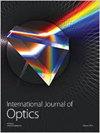基于TDLAS技术的种子呼吸CO2检测系统研究
IF 1.8
4区 物理与天体物理
Q3 OPTICS
引用次数: 0
摘要
传统的种子呼吸CO2浓度检测方法存在检测精度低、检测效率低、无法实时监测等缺陷。为了解决这些问题,我们报道了一种基于可调谐二极管激光吸收光谱(TDLAS)中波长调制光谱(WMS)技术的种子呼吸CO2检测系统。该系统采用2004 nm分布式反馈(DFB)激光器作为光源,设计了一种双层种子呼吸装置(约1.5 L),有效光程约为21米。然后,采用波长调制方法提取CO2浓度反演的二次谐波(2f)信号。当环境温度和压力变化较大时,采用校正后的2f信号进行CO2浓度反演,提高精度。一系列验证和对比实验证明,该种子呼吸CO2检测系统具有稳定性强、采样频率高、检测精度高等优点。最后,利用该系统测定了1 g玉米种子的呼吸强度和呼吸速率。呼吸强度曲线和呼吸速率变化细节表明,种子呼吸CO2检测系统比非色散红外(NDIR) CO2传感器和气相色谱法更适合于对少量种子的呼吸过程进行实时监测。本文章由计算机程序翻译,如有差异,请以英文原文为准。
Research on the Seed Respiration CO2 Detection System Based on TDLAS Technology
The traditional detection method of CO2 concentration in seed respiration has defects such as low detection accuracy, low detection efficiency, and inability to monitor in real time. In order to solve these problems, we report a seed respiration CO2 detection system based on wavelength modulation spectroscopy (WMS) techniques in tunable diode laser absorption spectroscopy (TDLAS). This system uses a 2004 nm distributed feedback (DFB) laser as the light source, and a double-layer seed respiration device (about 1.5 L) is designed based on Herriott cell with an effective optical path of about 21 meters. Then, the second harmonic (2f) signal is extracted by the wavelength modulation method for CO2 concentration inversion. When the ambient temperature and pressure changes greatly, the corrected 2f signal is used for CO2 concentration inversion to improve the accuracy. A series of verification and comparison experiments have proved that the seed respiration CO2 detection system has the advantages of strong stability, high sampling frequency, and high detection accuracy. Finally, we used the developed system to measure the respiration intensity and respiration rate of 1 g corn seeds. The respiration intensity curves and respiration rate change details show that the seed respiration CO2 detection system is more suitable for a small amount of seeds than nondispersive infrared (NDIR) CO2 sensor and gas chromatography in real-time monitoring of the breathing process.
求助全文
通过发布文献求助,成功后即可免费获取论文全文。
去求助
来源期刊

International Journal of Optics
Physics and Astronomy-Atomic and Molecular Physics, and Optics
CiteScore
3.40
自引率
5.90%
发文量
28
审稿时长
13 weeks
期刊介绍:
International Journal of Optics publishes papers on the nature of light, its properties and behaviours, and its interaction with matter. The journal considers both fundamental and highly applied studies, especially those that promise technological solutions for the next generation of systems and devices. As well as original research, International Journal of Optics also publishes focused review articles that examine the state of the art, identify emerging trends, and suggest future directions for developing fields.
 求助内容:
求助内容: 应助结果提醒方式:
应助结果提醒方式:


